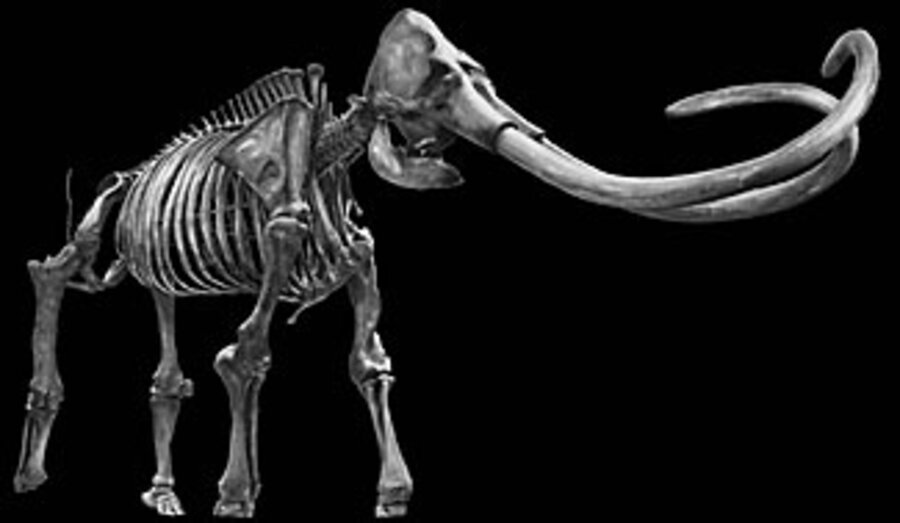The mystery of the mastodons gets a few big clues
Loading...
Ever since Europeans first uncovered mastodon fossils along Big Bone Lick in Kentucky in 1739, the demise of these huge animals and other lumbering contemporaries at the end of the last ice age has been an enduring puzzle to paleontologists.
Now, a team of researchers has evidence that woolly mammoths, huge ground sloths, and other Pleistocene giants became extinct earlier than previously thought.
The results appear to rule out at least one explanation scientists have offered up to explain the creatures' demise: an asteroid strike. Other theories – such as climate change and human hunters – remain possible, though the findings would shift the timeline more than 1,000 years backward.
Moreover, the research intriguingly suggests that the decline led to significant changes in the types and groupings of different plants within the animals' range, as well as an increase in the number of wildfires. In other words, it could have literally altered the landscape.
An 'elegant' study
The work, which was conducted at Appleman Lake in Indiana, is "elegant," says Eric Scott, a paleontologist at the San Berbardino County Museum who focuses on Pleistocene fossils, in an e-mail.
It neatly sidesteps a significant challenge paleontologists studying this issue face: "There is lack of sufficient numbers of well-dated vertebrate fossils, from multiple sites, from the time period in question," writes Dr. Scott.
Jaquelyn Gill, a graduate student on the research team at Appleman Lake, overcame that hurdle in an ingenious way: She used a particular species of fungus, Sporormiella, as a stand-in for the huge mammals. Sporormiella needs the digestive tracts of plant-eating animals to complete its life cycle. Spores found in fossilized dung have been associated with the huge animals, called megafauna.
"The use of Sporormiella as a proxy for the megaherbivores is rather inspired," Scott adds.
Surprise results
The results were something of a surprise, says John Williams, a University of Wisconsin paleoecologist and a member of the research team.
He and his colleagues had set out to study changes to plant communities during one period of the Pleistocene. They sought to gauge the relative role climate and the presence of huge mammals may have played in altering the mix of vegetation. The group was looking for clues that might help scientists anticipate potential ecological changes ahead as global warming progresses this century.
"Everything is happening all at once" during the time period his research targeted, he explains. "We see ice sheets retreating. We see carbon-dioxide concentrations rising. We see a major turnover in plant communities. Humans are arriving. And there's this set of large animals going extinct."
He and most of his colleagues suspected that climate change was the biggest driver behind the changes in plant communities at the time of the megaherbivores. But the results offer another possible interpretation: that it was the decline of the big animals that had the greatest impact on plant groupings.
The decline in megafauna clearly overlapped changes in plant groupings and changes in the presence of significant charcoal deposits, the research team found.
This suggests that forests might have spread as megafauna declined. Big animals, especially mammoths and mastodons, would have munched on small trees and saplings, limiting the expansion of woodlands. The spread of forests, then, would have provided fuel for more wildfires.
"What was very striking to me was how closely associated these three major things are," Dr. Williams says.
Revising the timeline
The timing seems to rule out three notions of what triggered the extinction of megafauna:
• A major collision between Earth and an asteroid or comet about 12,900 years ago
• The onset of a 1,300 year-long cold spell known as the Younger Dryas, which kicked in roughly 12,800 years ago.
• A blitzkrieg-like onslaught of human hunters as early as 13,300 years ago.
Yet climate and human involvement can't be ruled out, Williams says. The decline in megafauna does coincide with the onset of warming coming out of the last ice age. And some evidence suggests that humans were present on the continent at that time.
The team anticipates using its fungal-spore approach to expand its research beyond Appleman Lake to see if a similar picture emerges at other places around the country.
See also:
A mammoth find in the Valley of the Mastodons
New plan for the Great Plains: Bring back the Pleistocene
-----
Follow us on Twitter.





